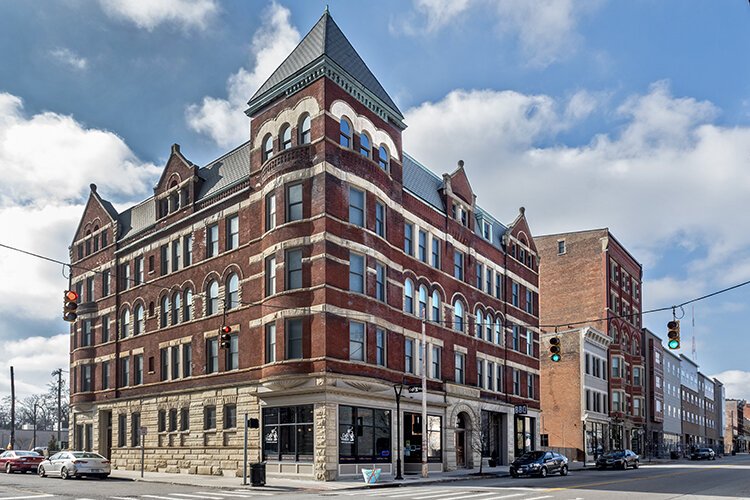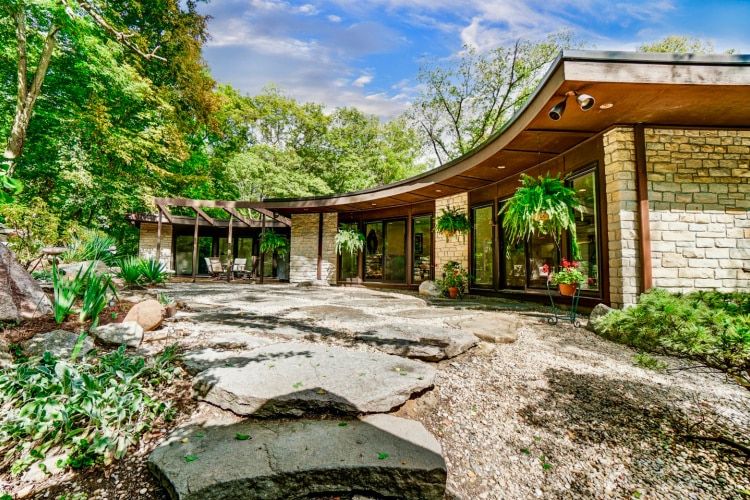On the Ground: A new wave of residents putting down roots brings stability to Walnut Hills
In the 1980s and 90s, the community's population shrank drastically, leading to urban blight and crime. But in the early 2000s, a wave of new, young urbanism brought a heightened interest in traditional, dense neighborhoods nearer to the urban core. With this heightened interest came a new willingness to invest capital in urban revitalization.

“The only thing constant is change,” the saying goes. And change is good, but change is hard.
Many Cincinnati neighborhoods are pushing through the growing pains of change, navigating current and future needs while also hoping to attract investment to build for the future.
Yes, change is good. But change is complicated.
Popular media here and elsewhere heralds the transformation of neighborhoods like Over-the-Rhine as a “comeback” from the dark days of Rust Belt disinvestment. But they don’t tell the whole story of what it’s like to live in a changing neighborhood with competing interests and visions.
In Walnut Hills, change happens (seemingly) overnight.
Historic buildings are restored. New buildings rise from the ground. Parking lots become community gathering spaces. Vacant lots become community gardens. Entire streets change direction.
While stakeholders work together to resurrect the infrastructure of the neighborhood, individuals invest their own kind of capital in shaping their community. By planting roots and building a livelihood, a new wave of residents is ushering in the next era of stability for Walnut Hills.
Rediscovering an urban gem
The end of the 20th century was not kind to urban communities. Wealthy residents fleeing to the suburbs, coupled with disinvestment by governments, employers, and service providers, left lower-income residents and other vulnerable populations trapped in empty neighborhoods with limited resources.
This was certainly true in Walnut HIlls where the population shrunk dramatically in the 1980s and 90s, and the neighborhood became a victim of urban blight and crime. But while, from the outside, Walnut Hills may have appeared plagued by decay, there was always a remnant of faithful pioneers holding fast until the tides shifted back in their favor.
In the early 2000s, a wave of new, young urbanism brought a heightened interest in traditional, dense neighborhoods nearer to the urban core. With this heightened interest came a new willingness to invest capital in urban revitalization.
Ironically, the “hottest” places to buy and invest in 2020 are the same places most investors would not have touched a decade or two ago, places just like Walnut Hills.
Yes, outside investment spurs growth, but it does not make a community. A true sense of belonging and “home” depends on relationships built on the sidewalk between neighbors and friends, and between business owners and their loyal patrons.
Walnut Hills has always had faithful pioneers. Now, the faithful pioneers are no longer alone.
A tide change and new voices of influence
Allen and Kyla Woods moved to Cincinnati from Indianapolis in 2011 when Kyla took a job as a news reporter for WLWT News 5.
Like many people who move from out of town for work, Allen and Kyla chose their first home in Anderson Township relatively sight unseen. The more they got to know Cincinnati and its neighborhood dynamics, they more they felt drawn to a more diverse urban neighborhood. Their first move was to Mt Washington. They stayed there for about five years.
Allen Woods is a founding member of the nonprofit MORTAR, an entrepreneurship hub that focuses special attention on empowering urban and underrepresented entrepreneurs. Kyla left her career in broadcasting a few years ago and now manages her own private communications firm and handles communications for MORTAR.
MORTAR opened its first storefront location in Over-the-Rhine in 2014 and then expanded to Walnut Hills in 2015. Since then, Allen and Kyla have spent a lot of time getting to know Walnut Hills and its history. They began attending community meetings and they’ve gotten to know the local heroes and urban pioneers who have loved the community through some trying times.
It wasn’t long before they started asking what part they could play in the next season of life for Walnut Hills. They talked about what it would look like to move to the neighborhood and make a personal — more than professional — investment in its future.
They were both on board, but the decision still wasn’t easy.
Kyla, especially, really enjoyed living in Mt Washington for its walkability and public greenspace. And though Walnut Hills meets that same criteria, there are many corners and streets still plagued by blight and crime.
“Depending on where you walk or drive,” Kyla says, “it may or may not feel safe.” The Woodses also have the safety of their two daughters to consider.
But Allen and Kyla weren’t thinking only of themselves; they wanted to be a catalyst for growth in the neighborhood.
“We asked,” Allen says, “‘What does this look like realistically for our family? How can we come to Walnut Hills and be a part of what is growing here without erasing what has been?’”
Kyla says that they wanted to help preserve the cultural heritage and integrity of the neighborhood and “respect the legacy” of Walnut Hills. They knew the neighborhood was in a vulnerable place, on the brink of a lot of changes that could radically affect its residents. With redevelopment so young, they thought it was probably early enough to still have an influence in the future.
But any investment is a gamble.
In a transitional neighborhood, a persistent fear among current residents is their lack of control and their vulnerability to the whims of decision-makers. This fear is amplified among people of color because, Allen notes, black people have not always been a welcome influence, even in their own neighborhoods.
“The money tends to not flow when the residents have more melanin,” he explains.
However, Walnut Hills has always been a uniquely diverse neighborhood.
When so many places in the US were hostile for black people after abolition, Walnut Hills was a haven. More than that, it became a thriving microcosm of African-American culture, with a stable economy, successful schools, and a wealth of opportunity for business owners well into the middle of the 20th century.
But even though Walnut Hills has always been diverse, moving their family to the neighborhood meant banking on the hope that the neighborhood would remain that way in the future. Even without a guarantee, they took the leap and they moved to Walnut Hills about a year ago.
Passing the baton
Mark and Lily McEwan started spending time in Walnut Hills in 2008, while studying at the University of Cincinnati. They frequently volunteered with a college-age ministry called Mission: Urban Development, doing things like renovating low-income housing and picking up litter.
Volunteering in Walnut Hills was their first real exposure to urban poverty and Mark says it was “culture shock” to see the quality of life of those living only a mile from his home on UC’s campus.
During those four years, Walnut Hills won a place in their hearts and, after graduating in 2012 and marrying a few months later, they decided that moving to the neighborhood made more sense than moving anywhere else.
Lily explains, “For us it was important to be in close proximity to the urban core and Mark — who works as an operations manager for Cincinnati Metro — wanted to be in a place that has good public transportation. We also wanted old, beautiful architecture, lots of character, different racial and socio-economic makeup, and to push ourselves out of our comfort zone.”
But their connection to the community and the relationships they’d built throughout college were the most compelling reason to live in Walnut Hills. It already felt like home.
Since 2008, the McEwans have watched Walnut Hills change a lot. And they’ve felt the tension between wanting a Walnut Hills that is more comfortable for people like them — young, white, urbanites — and wanting the Walnut Hills they first fell in love with.
The changes are basically good, Lily says, and they love almost everything new to the neighborhood.
“The challenge,” she explains, “is not letting this swallow up the ethos of what Walnut Hills was and what it could be. I think there is a decent amount of mourning on our end for the things that we’ve lost to make way for all the ‘New! New! New!’ happening around us.”
In 2017, while expecting their second child, the McEwans decided they were ready to purchase a home in the neighborhood but they found they’d already been effectively priced out of the market. Thankfully, a friend of theirs approached them about purchasing her house. She had been in the neighborhood for more than twenty years and was hoping to entrust her home to a new family who would pursue an equitable future for Walnut Hills.
“Passing this conviction from one family to another through the purchase of a home felt right to us,” Lily says. “So we did it.”
A different model for revitalization

The foundation for a thriving Walnut Hills was laid long before the Woods and McEwan families ever stepped foot in the neighborhood.
In the 1960s, Walnut Hills residents established the Walnut Hills Area Council, which became the primary organizing body for the neighborhood and helped focus early efforts in grassroots revitalization. Since then, many more neighborhood organizations have been spawned and outside organizations have joined the community, helping create a robust culture of community engagement.
Walnut Hills now has its own business association, historical association, and a faith alliance, and the neighborhood is home to the Greater Cincinnati/Northern Kentucky African American Chamber of Commerce, Easterseals, and United Way (among others).
In 1977, the Walnut Hills Redevelopment Foundation was established to address the issue of affordable housing in the neighborhood. In recent years, the nonprofit has adopted a more active role in charting the path for the future and directing new investments and development in the neighborhood.
Walnut Hills is becoming a truly desirable 21st century community, the kind of place empty-nesters, urban professionals, and young families now crave. But it could have been bulldozed off the map forty years ago, as plenty of similar communities were, had it not been for the activists and neighborhood associations that rose to the task of preserving their beloved home.
All housing stock and architecture and greenspace aside, the level of commitment and investment made by Walnut Hills residents is truly its greatest asset. And the Woodses and McEwans are committed to honoring that as they carve out their unique contributions to the neighborhood.
Allen and Kyla Woods, for example, care deeply about the issue of equal representation and equal opportunity. The first step, Allen says, is “claiming a seat at the table” and then welcoming others to do the same.
They also want to be part of a movement in the black community that reverses the tendency for successful people to move “up and out” of the city. Instead of asking for more and more investment from outside sources, Kyla explains, “we need to have a conversation around how to get the black community to invest in the inner-city neighborhoods.”
And now nearing a decade in the neighborhood, the McEwans feel like their role in the community is shifting as the demographics of the neighborhood shift around them. At one time they were in the minority, but the neighborhood is attracting more people just like them and, soon, they may wield more influence.
“It means it’s even more important for us to act as a voice for those that don’t have the money, standing, or power to stand up against development,” Mark explains.
He says they spent a great deal of 2019 advocating with their neighbors against a large-scale development across the street.
“It was a really cool way to regularly gather with neighbors, new and old, and hash out the things we considered worth fighting for in our neighborhood,” he remembers. “We want that same enthusiasm for every street in Walnut Hills, to make [neighborhood] decisions based on time spent with the people who live here and work here.”
The On The Ground Walnut Hills feature series is made possible by a grant from
The Carol Ann and Ralph V. Haile, Jr. / U. S. Bank Foundation.
The Walnut Hills Community Open Newsroom and Groundsource projects are made possible by a grant from the Facebook Journalism Project.














